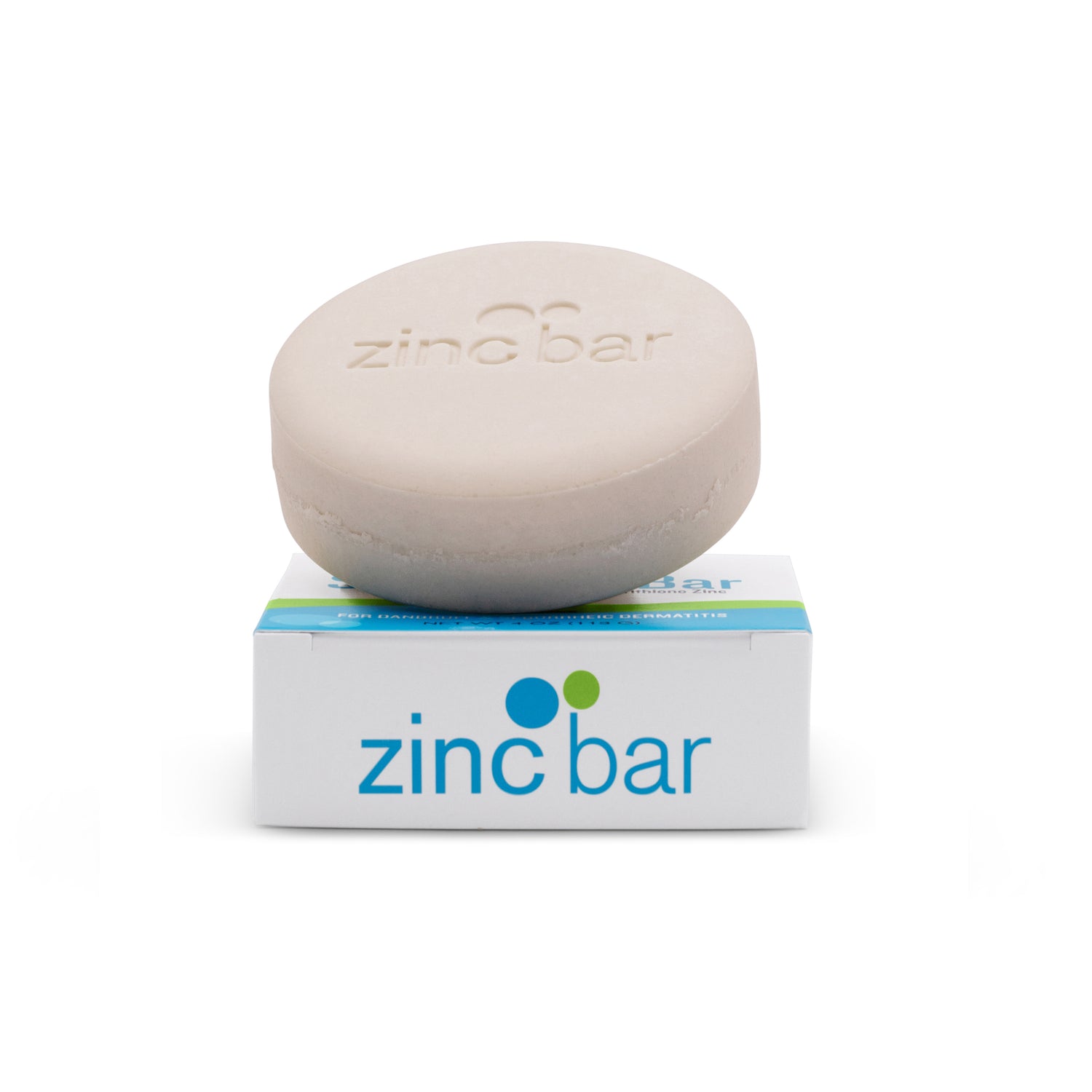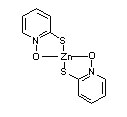All about pyrithione zinc (peer-i-THYE-ohn)
Pyrithione zinc is an antibacterial and antifungal agent developed by scientists in the 1930's. Zinc pyrithione is a derivative of pyrithione (1-hydroxy-2-pyridinethione) — it is a lab-made coordination complex of zinc. Pyrithione is the common name of an organosulfur compound. Zinc pyrithione is a fine white powder typically used as an aqueous solution to reduce the substance from going airborne during production. It is not a grey/black mineral. Since the 30's it has been used to treat seborrheic dermatitis of the scalp and other skin conditions such as eczema, athlete's foot, and vitiligo, as well as psoriasis. Because of its antifungal properties, it is commonly found in dandruff shampoo.
[Regulatory Note: The US Food & Drug Administration does not allow antifungal claims for pyrithione zinc. A finished formulation sold in the United States that contains Zinc Pyrithione cannot include any antimicrobial claims or reference the biocidal nature of the material against any particular organism. It may be used in rinse-off deodorant applications but cannot be used as an active ingredient to make antimicrobial claims, including when used in cosmetic grade deodorant or antibacterial handwash/soap applications. The FDA has classified deodorants as cosmetics and Pyrithione Zinc is not listed in the FDA’s Tentative Monograph: OTC Healthcare Antiseptic Drug Products.
The European Union (EU) recently restricted the use of pyrithione zinc because of its 'potential' to damage DNA. Note that the FDA considers pyrithione zinc safe. So does EWD Skin Deep. Especially safe in limited-contact wash off products such as soaps and shampoos. The EU now favors "suitable alternatives" selenium sulfide, piroctone olamine, ketokonazole, or coal tar. The function of these ingredients is the same: to kill Malassezia (the yeast causes skin flakes). In the USA selenium sulfide is considered so toxic that manufacturers who work with it are required by OSHA to wear full hazmat suits. That's not the case with pyrithione zinc — it is safe and easy to work with.
Products containing pyrithione zinc are available today with and without prescription in the United States and most of the world, and it is the main ingredient in many over-the-counter creams, lotions, soaps, and shampoos.
Synonyms: ZPT; bis(1-hydroxy-2(1H)-pyridineselonato-O,S)zinc
Molecular Formula: C10H8N2O2S2Zn
Molecular Weight: 317.7
Melting point (Mp): >240°C
Pyrithione zinc has a number of qualities that may be helpful in alleviating psoriasis symptoms. It is an antiseborrheic, which means that it helps to prevent or relieve excessive secretions of the sebaceous glands. These glands lie beneath the skin and are usually connected with hair follicles. Their function is to soften and lubricate the skin and hair. When sebaceous glands become overactive, an inflammatory skin rash known as seborrheic dermatitis can result. Pyrithione zinc also has both antifungal and antibacterial properties, which may help reduce inflammation on the skin and provide added relief for psoriasis sufferers. Topical zinc pyrithione is generally recognized as a safe and effective treatment for reduction in scale, erythema, and pruritus and can be applied and left on the skin or scalp for the control of dandruff and seborrheic dermatitis.
The effectiveness of pyrithione zinc is well-established, but as with many modern medicines that have evolved from time-tested remedies, the way the drug actually works is less clear. Many scientists believe that pyrithione zinc slows down mitosis (cell division) and reduces the turnover of skin cells. Pyrithione zinc also slows down the growth of bacteria and fungi on the skin, but researchers have not yet determined whether this contributes to the antiseborrheic effects of the drug.
Pyrithione zinc history
For centuries zinc has been recognized for its unique healing properties. In the 13th century Marco Polo observed that the Persians used tutia (meaning zinc oxide, or perhaps zinc sulphate) to heal wounds and sore eyes. Eighteenth-century apothecaries in Colonial Williamsburg, Virginia dispensed skin remedies made from calamine, a mineral form of zinc. Today most medicine cabinets still contain calamine lotion.
Zinc was a common symbol of wealth in ancient times. The Romans believed that brass made from calamine, charcoal, and granules of copper was indistinguishable from gold. Metallic zinc was known in India by the year 1200 AD and in China by 1600 AD. Zinc production has evolved steadily over the last 500 years, and zinc sulphate ores have replaced zinc oxides as primary sources.
New uses for zinc continue to be found. 3M Corporation puts pyrithione zinc into household sponges as an antibacterial treatment. It is also used in polyester clothing to prevent microbe growth. Cotton is also sometimes finished with a zinc pyrithine complex to inhibit bacterial growth. The modern uses are many.
Zinc—an essential nutrient
Zinc is an essential nutrient and is crucial to the proper functioning of at least 70 different enzymes. It plays a key role in collagen formation as well as maintaining blood stability. Research is currently being conducted to determine the impact of zinc on brain activity and possible effects it may have on disorders such as schizophrenia. Evidence also shows that zinc may be an immune system booster, and it is often found as an ingredient in lozenges for use in combating the common cold and sore throat.
Zinc deficiency can result in significant health problems arising from impaired synthesis of DNA, RNA and various proteins. Excessive sweating and intestinal problems such as diarrhea can increase zinc loss. Common dietary sources of zinc include chickpeas, baked beans, cheddar cheese, and yogurt. Unfortunately, due to poor soil and over-processed food, zinc is often present in substandard amounts in our diets.
Side effects of pyrithione zinc
Pyrithione zinc has few known side effects, but in rare instances products that contain it may cause skin irritation or a burning sensation. Pyrithione zinc has not been shown to cause birth defects or to cause problems in nursing babies. There are no indications that its effect on children or older adults is different from any other group, and no adverse interactions with other medicines are known. Notwithstanding, there is evidence suggesting toxic effects at moderate doses (doses much higher than 2%).
Antidandruff topicals containing 1% to 2% zinc pyrithione has been used extensively worldwide for many years by a large number of people with no apparent ill effects. Pyrithione zinc soaps, creams, and shampoos have no apparent toxicity when applied as directed to normal skin and hair.
FDA regulations specify how much pyrithione zinc a product can contain. Allowable concentrations are based upon how long the product is likely to remain in contact with the skin. Higher concentrations are allowed for products made to be applied and washed off than for products meant to be applied and left on the skin or scalp.
Our products
DermaHarmony makes dermatologist recommended pyrithione zinc soaps, shampoos, and creams. Our National Drug Code (NDC) Labeler Code is 71819. We make both OTC and non-OTC zinc products.


